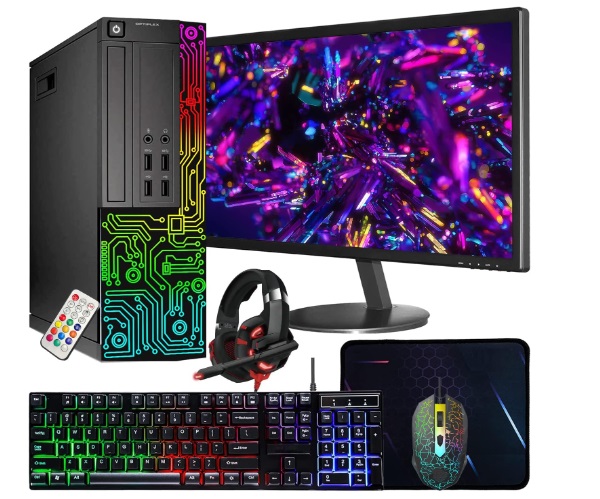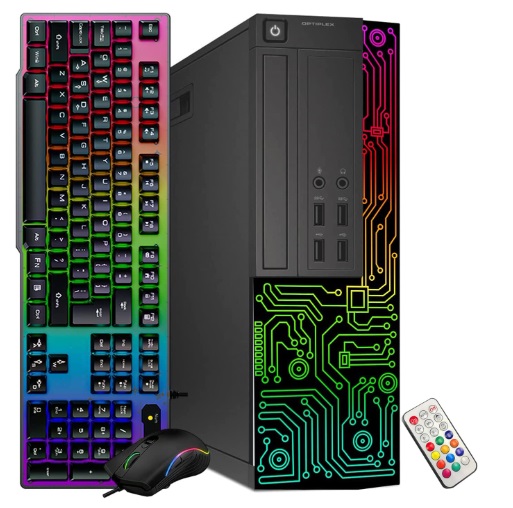
Dell Optiplex Small Desktop Computer (SFF) PC review
Click Picture and Video & Price & More
When it comes to compact, reliable, and versatile desktop solutions, the Dell OptiPlex series has long been a favorite in the small form factor (SFF) market. Dell’s OptiPlex Small Desktop Computer (SFF) PC aims to combine powerful performance with a space-saving design, making it suitable for both business and personal use. This review will cover its design, performance, features, and overall value, while also considering some of its drawbacks. Ultimately, we’ll explore whether this model is worth the investment.
Design and Build Quality of Dell Optiplex Small Desktop Computer (SFF) PC review
To begin with, the Dell OptiPlex SFF’s design is one of its most defining features. Dell has managed to pack considerable power into a compact chassis without compromising on durability. The OptiPlex SFF is sturdy and robust, featuring a sleek and minimalist design that fits seamlessly into any office or home environment. Thanks to its small form factor, it occupies significantly less desk space compared to traditional desktop towers, allowing for a more organized workspace. Furthermore, the SFF design also enhances portability, making it easy to move or reposition the unit when necessary.
However, while the design is undoubtedly sleek and professional, some users may find the lack of upgrade options limiting. Given the compact nature of the chassis, space for additional internal components is minimal. This limitation is particularly important to note if you anticipate needing substantial upgrades over time. Nevertheless, for most users, the design will be more than satisfactory, especially if ease of use and aesthetics are top priorities.

Click Picture and Video & Price & More
Performance and Processing Power of Dell Optiplex Small Desktop Computer (SFF) PC review
One of the Dell OptiPlex SFF’s primary selling points is its impressive processing power for a small desktop. Equipped with various configurations, including Intel Core i3, i5, and i7 processors, the OptiPlex SFF can handle multitasking with ease, from basic applications like word processing to more demanding software such as video editing tools. Depending on the chosen configuration, users can tailor their desktop to match their specific needs.
In addition, the Dell OptiPlex SFF typically offers up to 32GB of RAM, which significantly boosts its performance, particularly for multitasking. This makes it a suitable choice for professionals who work with multiple programs simultaneously or handle data-intensive applications. On the other hand, for those interested in gaming or high-end graphical work, it’s important to note that the OptiPlex SFF isn’t designed for such tasks. While it may support certain low- to mid-range GPUs, it lacks the power and thermal capacity for advanced graphics cards, making it more suitable for general productivity tasks.
Storage and Connectivity Options of Dell Optiplex Small Desktop Computer (SFF) PC review
Equally important to consider are the storage options provided by the Dell OptiPlex SFF. It offers multiple configurations, often with a blend of solid-state drives (SSD) and hard disk drives (HDD). The SSD options provide faster boot times and improved data access, while the additional HDD allows for more storage space at a lower cost, making it ideal for storing larger files. Users can typically select between 256GB, 512GB, or even 1TB SSD options, which should be ample for most office or personal applications. However, as with the design, users may find the lack of additional internal slots limiting if they need extensive storage.
Moreover, Dell has ensured that the OptiPlex SFF is well-equipped with connectivity options. It includes several USB ports (both USB 2.0 and USB 3.0), DisplayPort, HDMI, Ethernet, and audio ports, making it highly adaptable to various peripherals and displays. This makes it convenient for users who rely on multiple devices, such as printers, external drives, and additional monitors, in their daily operations.
Security and Manageability Features
In today’s business environment, security is crucial, and Dell has not overlooked this in the OptiPlex SFF. The device includes Dell’s trusted BIOS and security features, which help safeguard against unauthorized access. Additionally, the OptiPlex SFF supports TPM (Trusted Platform Module) for enhanced hardware-based security, making it an appealing choice for businesses handling sensitive data.
Dell’s manageability suite also simplifies IT tasks, allowing for remote management and troubleshooting. This is particularly advantageous for larger organizations or IT teams, as it reduces maintenance time and costs.
Energy Efficiency and Eco-Friendliness
Another standout feature of the Dell OptiPlex SFF is its energy-efficient design. It complies with several environmental standards, including ENERGY STAR and EPEAT, which ensure that it consumes less power than many traditional desktops. Not only does this reduce energy costs, but it also lessens the environmental impact, which is a major consideration for eco-conscious users.
In addition, the SFF model is constructed from post-consumer recycled materials, emphasizing Dell’s commitment to sustainability. This factor, although not directly influencing performance, is a great selling point for individuals or organizations looking to reduce their carbon footprint.
Value and Pricing
In terms of value, the Dell OptiPlex SFF offers a compelling package. While there are cheaper alternatives on the market, the OptiPlex SFF justifies its price by providing durability, security, and reliable performance. Its cost-effectiveness increases further when considering Dell’s warranty and customer support services, which are often well-regarded.
For those on a tight budget, Dell also offers refurbished models of the OptiPlex SFF. These refurbished units provide a more affordable option without sacrificing quality, making the OptiPlex lineup accessible to a broader audience.
Drawbacks to Consider
Though the Dell OptiPlex SFF has much to offer, it does come with some limitations. Firstly, the small form factor restricts internal upgrades, as previously mentioned. While this may not be an issue for casual users or small businesses, those with plans for significant hardware customization may find it frustrating. Additionally, the lack of advanced graphics capabilities limits its potential for gamers or users who require high-end graphical processing.
Lastly, while Dell’s customer support is generally good, the OptiPlex series doesn’t come with the same level of customization options as some other desktop lines, which might limit users looking for more tailored configurations.
Final Verdict
In conclusion, the Dell OptiPlex Small Desktop Computer (SFF) is a solid choice for users who value a compact design, reliable performance, and strong security features. With its impressive processing power, connectivity options, and eco-friendly design, it is particularly well-suited for small to medium-sized businesses, professionals, and general users seeking a durable, space-saving desktop solution.
For those with more specific needs, such as heavy graphical processing or extensive internal upgrades, the OptiPlex SFF might not be the best fit. Nonetheless, for the majority of users, the Dell OptiPlex SFF is a dependable, energy-efficient, and secure option that stands out in the compact desktop market.
In short, if you’re in search of a trustworthy, space-saving desktop that performs well in a range of environments, the Dell OptiPlex SFF is worth considering. Its balance of features and value make it a worthwhile investment for both personal and professional use.
More review: Beelink GTi14 Mini PC